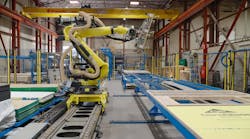Nowhere is building automation more “mission-critical” than in life-sciences industries, where drug products and medical devices are developed, manufactured, and tested. Today's typical life-sciences campus includes structures as varied as offices, laboratories, animal-care facilities, manufacturing buildings, and warehouses. This article will provide an overview of building-automation requirements in regulated pharmaceutical-manufacturing facilities.
Facilities in which food and drug products for human use are developed, manufactured, tested, or stored must meet the dictates of the U.S. Food and Drug Administration (FDA). Additionally, industry-accepted “good practices” for laboratories, engineering, manufacturing, and automated manufacturing must be followed (Figure 1). These regulations and requirements are in effect throughout the life of a facility, from conceptualization through decommissioning. Failure to comply puts the owner at both regulatory and business risk. For instance, recently, contamination problems at a manufacturing facility resulted in action by both British and U.S. regulators, leading to a significant disruption in the world's supply of flu vaccine.
To minimize such risk, facilities are constructed under a rigorous and well-defined quality-control system. Current engineering and quality-assurance practices relating to facility construction can be found in the International Society for Pharmaceutical Engineering's (ISPE's) “Commissioning and Qualification Baseline Guide”1 (Volume 5 in the ISPE's Baseline Pharmaceutical Engineering Guides series). Practices for automation are addressed in Version 4 of “The Good Automated Manufacturing Practice (GAMP) Guide for Validation of Automated Systems in Pharmaceutical Manufacture” (“GAMP 4”).2
CONTROL-SYSTEM LIFE CYCLE
According to “GAMP 4,” the life cycle of a control system for a building-automation system (BAS) serving a production facility starts with the development of a user-requirement specification (URS) (Figure 2). A URS defines what a system is intended to do and what its user's essential needs are. After the URS, a functional specification (FS) is developed. An FS describes what a system will be required to do and what features it must have to meet user requirements. While a URS is general (e.g., “the system must alarm on key parameters”), an FS is detailed (e.g., “each space temperature will require high, low, high-high, and low-low alarms”) and often used as the basis of automation contracts. The successful contractor compiles a detailed design specification (DDS), which, in addition to shop drawings and equipment cut sheets, includes a detailed description of system architecture, hardware, and software integration and how the requirements of both the URS and FS will be met.
Each of these documents is reviewed and approved by the cognizant user, as well as engineering, production, and quality-assurance personnel. And each is critical to the quality-control process, which is defined in the ISPE's “Validation of Process Control Systems” GAMP Good Practice Guide.3
The GAMP quality-assurance process relies on testing at various stages of development. The testing begins with common software modules and is performed in accordance with formalized and approved test protocols. For control-panel hardware, controller software, system servers, and workstations, factory acceptance testing (FAT) generally is required prior to installation. Once the system is installed and connected to the equipment it is intended to control, site acceptance testing (SAT) is conducted.
FAT and SAT protocols and execution typically are the responsibility of the supplier or a third-party commissioning agent and witnessed by a quality-assurance representative of the owner. Final test results are reviewed and approved by the design documents' signatories. The advantage of the FAT and SAT process is that changes required to correct deficiencies can be made “on the fly” as testing progresses, provided they are recorded and design documentation is updated.
The intent of FAT and SAT is to identify and correct problems before a system falls under the watchful eyes of regulators. Once the steps are completed, system “qualification” can begin. The system then falls under “change control.” Identifying and correcting deviations at this stage is costly in terms of delays and schedule slippage, as system software is “locked down.” Each deviation must be brought to the attention of the quality-assurance authority and the proposed remedy reviewed and formally approved.
The “validation” of a control system occurs in three phases:
-
Installation qualification, during which the equipment is verified to match what was approved in the DDS.
-
Operational qualification, during which the system is verified to perform as described in the FS.
-
Performance qualification, during which the system is verified to meet the requirements dictated by the URS.
A “traceability matrix” is maintained throughout the validation process to ensure specification requirements are addressed during design, installation, and testing.
The final quality-assurance requirements to be met before a system is placed into operation include the development and implementation of standard operating procedures (SOPs) and the training of personnel responsible for using and maintaining the system. Typically, SOPs for a BAS concern disaster recovery, backup and archiving, user rights and password assignment, maintenance, and change management.
HVAC CONTROL APPLICATIONS
In drug manufacturing, how space conditions impact the product being made is of primary importance. Space pressurization and volumetric flow rate are controlled to prevent contamination by dirt and pathogens, as well as cross-contamination from the production of other drugs in the facility. Humidity can affect the efficacy and stability of drugs or how effectively they can be pressed into tablets. Temperature can affect production directly or indirectly by fostering the growth of microbial contaminants on workers. Each environmental parameter to be controlled must be evaluated in light of its potential to impact product quality.
In general, fixed-function, configurable controllers, such as those used for variable-air-volume boxes, are not well-suited to pharmaceutical manufacturing because of their inflexibility. Programmable types of controllers are better-suited, with those that can be programmed in a high-level language the best. This is because GAMP holds that all programs be annotated so they can be supported relatively easily throughout the system life cycle. Also, language-based control simplifies the formalized “code-review” process required for most projects involving manufacturing facilities.
Instrument-loop accuracy — the accuracy of a measurement device, plus that of the controller input to which the device is connected — is another chief concern. Because they need to be checked regularly, qualified control instruments should be installed in locations facilitating calibration and maintenance.
Of secondary concern is the selection of field equipment. With some drug products manufactured in hazardous environments, controls must be intrinsically safe or explosion-proof. And with many manufacturing areas subject to washdown, instruments must be able to withstand being deluged with water and cleaning agents. Humidifiers and control valves serving sterile manufacturing areas may need to be made of stainless steel and suitable for clean-in-place sterilization, as the water vapor they disperse into the air may come in contact with the drug product.
NETWORK ARCHITECTURE
All fiber-optic, Ethernet, and twisted-pair field control networks in manufacturing facilities must be qualified and validated. Commonly, a validated network infrastructure is utilized for fiber-optic and Ethernet communications, eliminating the need to provide and validate a dedicated TCP/IP network. Bridging to non-validated networks, such as a campuswide BAS network, is routine, but requires validation testing to substantiate that safeguards precluding changes by unauthorized personnel are in place. Even routine operator actions, such as acknowledging alarms and changing set points, should be segregated by departmental authority, functional responsibility, and evidence of proper training.
Regulated and non-regulated operations are integrated as shown in Figure 3. In a production facility, these also may include specialty utilities, such as clean steam, U.S. Pharmacopeia water, and clean compressed air, which must interface with the BAS as well. Because production and quality-assurance personnel must monitor equipment and environmental status, local workstations often are required at production sites. User rights and access privileges must be segregated so that changes are made by authorized individuals only.
While facility managers typically require short-term data for troubleshooting and the resolution of equipment problems, production and quality-assurance personnel are more concerned with long-term records of environmental trend data, alarms, and operator actions, which are used to substantiate that products were manufactured within the environmental-tolerance envelope identified in product licenses. Because these records may need to be retained for years, they fall under the FDA's 21CFR Part 11 guidelines for electronic-record retention and protection. Because of potential problems associated with mixing production-oriented data and building-automation data, a stand-alone data-archiving server often is used for production records.
CONCLUSION
Pharmaceutical facilities have control needs that are both unique and complex. Control-system providers must pay special attention to detail throughout design and installation and conform to quality-assurance requirements that are far more stringent than those they are likely to encounter on other projects. For those who master the requirements, the rewards are many, as drug makers recognize the value a competent controls contractor brings to a project and usually reward such individuals with repeat business.
REFERENCES
-
ISPE. (2001). Commissioning and qualification baseline guide. Tampa, FL: International Society for Pharmaceutical Engineering.
-
ISPE. (2001). The good automated manufacturing practice (GAMP) guide for validation of automated systems in pharmaceutical manufacture. Tampa, FL: International Society for Pharmaceutical Engineering.
-
ISPE. (2003). Validation of process control systems. Tampa, FL: International Society for Pharmaceutical Engineering.
The founder and principal of Facility Diagnostics Inc., an engineering-services provider specializing in mission-sensitive ventilation systems and their controls, Ken Kolkebeck has more than 30 years of experience in the controls field. He holds patents for airflow-measuring and fume-hood-control devices and is past chairman of Air Movement and Control Association (AMCA) International Inc.'s Airflow Measurement Station Division and the co-author of ANSI/AMCA Standard 610, Methods of Testing Airflow Measurement Stations for Rating.
For HPAC Engineering feature articles dating back to January 1992, visit www.hpac.com.








